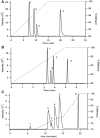Multidimensional Liquid Chromatography Coupled with Tandem Mass Spectrometry for Identification of Bioactive Fatty Acyl Derivatives
- PMID: 28018237
- PMCID: PMC5156705
- DOI: 10.3389/fphys.2016.00608
Multidimensional Liquid Chromatography Coupled with Tandem Mass Spectrometry for Identification of Bioactive Fatty Acyl Derivatives
Abstract
Recognition of the contributions of lipids to cellular physiology, both as structural components of the membrane and as modulatory ligands for membrane proteins, has increased in recent years with the development of the biophysical and biochemical tools to examine these effects. Their modulatory roles in ion channels and transporters function have been extensively characterized, with the molecular mechanisms of these activities being the subject of intense scrutiny. The physiological significance of lipids in biochemistry is expanding as numerous fatty acyls are discovered to possess signaling properties. These bioactive lipids are often found in quantities of pmol/g of tissue and are co-extracted with numerous lipophilic molecules, making their detection and identification challenging. Common analytical methodologies involve chromatographic separation and mass spectrometric techniques; however, a single chromatographic step is typically ineffective due to the complexity of the biological samples. It is, therefore, essential to develop approaches that incorporate multiple dimensions of separation. Described in this manuscript are normal phase and reversed phase separation strategies for lipids that include detection of the bioactive primary fatty acid amides and N-acyl glycines via tandem mass spectrometry. Concerted utilization of these approaches are then used to separate and sensitively identify primary fatty acid amides extracted from homogenized tissue, using mouse brains as a test case.
Keywords: N-acyl ethanolamines; N-acyl glycines; bioactive lipids; fatty acyls; lipid-protein interactions; multidimensional liquid chromatography; primary fatty acid amides.
Figures




Similar articles
-
Off-line mixed-mode liquid chromatography coupled with reversed phase high performance liquid chromatography-high resolution mass spectrometry to improve coverage in lipidomics analysis.Anal Chim Acta. 2017 Feb 15;954:140-150. doi: 10.1016/j.aca.2016.12.003. Epub 2016 Dec 10. Anal Chim Acta. 2017. PMID: 28081809 Free PMC article.
-
Recent advances in analytical strategies for mass spectrometry-based lipidomics.Anal Chim Acta. 2020 Nov 15;1137:156-169. doi: 10.1016/j.aca.2020.09.060. Epub 2020 Sep 30. Anal Chim Acta. 2020. PMID: 33153599 Free PMC article. Review.
-
Analysis of (O-acyl) alpha- and omega-hydroxy fatty acids in vernix caseosa by high-performance liquid chromatography-Orbitrap mass spectrometry.Anal Bioanal Chem. 2020 Apr;412(10):2291-2302. doi: 10.1007/s00216-019-02348-2. Epub 2020 Jan 6. Anal Bioanal Chem. 2020. PMID: 31907593
-
Targeted lipidomics: fatty acid amides and pain modulation.Prostaglandins Other Lipid Mediat. 2005 Sep;77(1-4):35-45. doi: 10.1016/j.prostaglandins.2004.09.017. Epub 2004 Nov 24. Prostaglandins Other Lipid Mediat. 2005. PMID: 16099389 Review.
-
Integrating the potential of ion mobility spectrometry-mass spectrometry in the separation and structural characterisation of lipid isomers.Front Mol Biosci. 2023 Mar 16;10:1112521. doi: 10.3389/fmolb.2023.1112521. eCollection 2023. Front Mol Biosci. 2023. PMID: 37006618 Free PMC article. Review.
Cited by
-
Tissue storage affects lipidome profiling in comparison to in vivo microsampling approach.Sci Rep. 2018 May 3;8(1):6980. doi: 10.1038/s41598-018-25428-2. Sci Rep. 2018. PMID: 29725071 Free PMC article.
-
Single-Cell Proteomics: The Critical Role of Nanotechnology.Int J Mol Sci. 2022 Jun 16;23(12):6707. doi: 10.3390/ijms23126707. Int J Mol Sci. 2022. PMID: 35743151 Free PMC article. Review.
References
Grants and funding
LinkOut - more resources
Full Text Sources
Other Literature Sources

